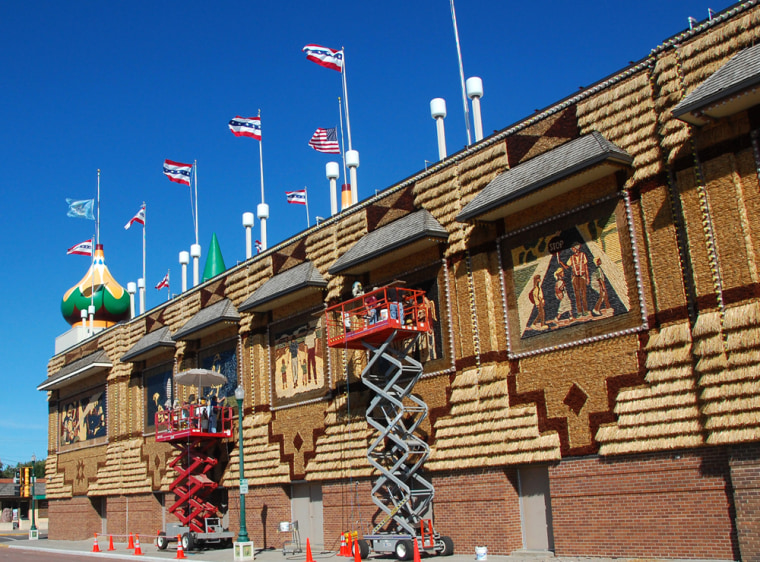"Extreme Makeover: Corn Edition" has returned to the World's Only Corn Palace after a one-year hiatus.
A severe drought last season forced the "a-maize-ing" South Dakota tourist attraction to skip its annual redesign because there wasn't enough colored corn to cover the building's facade.
But decorators armed with nail guns are back on their scaffoldings this fall to turn trailer-loads of corn cobs into works of art.
Seeing the workers create the murals was a treat for Canadian tourist Marilee O'Neil, one of about a half-million visitors who drop by the Corn Palace each year.
O'Neil said she read about the attraction and thought the Russian-looking building — complete with domes and minarets — looked interesting, so she and her husband, Dave, decided to check it out during their road trip out west.
"In the photo I had seen in the magazine, I just saw the front," said O'Neil, of Thunder Bay, Ontario. "I had no idea there'd be other pictures on it. It's fantastic."
The annual redesign, which carries a price tag of about $130,000, begins the end of May when workers start tearing down the rye and sour dock that adorn the murals, said Corn Palace Director Mark Schilling.
Once fresh grains are in place, workers start dismantling the previous year's corn murals.
"We're usually putting up our patterns just in time for Corn Palace Festival, which occurs about the 20th of August each year," Schilling said.
Since the Corn Palace debuted in 1892, its palette has grown to 12 distinct shades of corn: black, blue, white, variegated orange, calico, yellow, green, light and dark brown, and light, medium and dark red. And yes, all those colors are natural.
Each mural begins as a smaller painting.
Cherie Ramsdell, Dakota Wesleyan University assistant art professor, created this year's drawings, all part of an "Everyday Heroes" theme honoring teachers, power linemen, policemen, parents and crossing guards.
Using a projector, Ramsdell's drawings are outlined onto full-size black tar paper in a "corn-by-numbers" pattern that tells the decorators where to nail each colored cob.
"So the artist will put down that green is needed in one area, brown is needed in another and then it becomes up to our decorators to really bring the picture to life," Schilling said.
Once the full cobs are sorted by color, workers use a miter saw to cut off the ends before splitting them in half using a specially designed saw, said Randy Meinke, one of the decorators.
"It's pretty relatively easily considering the artist draws everything out, you know," Meinke said. "It's just your job to put in the ears, the right color and stuff."
Larry Degen, who's been creating Corn Palace murals off and on for about 20 years, said the decorators decide at which angle to run the various colors.
"Like on this one here, OK, you've got blue up there on the skyline, we'll run that at an angle," Degen said. "There at the end picture, you've got the sun and the bursts, we'll run all them at an angle.
"You've just kind of got to use your own judgment."
With the edge cut straight, workers can butt each halved corn cob up to the next, but as the corn dries, shrinkage creates small gaps.
"The more nails you put in, the less shrinkage it's going to get," said Degen.
All the Corn Palace corn is grown locally by Wade Strand, who took over the contract from his second cousin about three years ago.
"Twenty years ago, 25 years ago, 5 acres of corn decorated the palace," Strand said. "Now I grow 40 to 50 acres just to have all the different colors."
It's an involved process.
Strand must buffer his fields so colors don't cross-pollinate, and he needs to pay close attention to each kernel's color when sorting for seed to produce next year's Corn Palace crop.
Strand said it's a shame that the Corn Palace can't be redecorated at the height of tourist season so more people could see the process.
"But even this time of year, there are tourists coming through and we're up there sorting corn, unloading corn and they come out and just marvel at all the colors on the trailer and stuff," he said. "It's pretty neat."
